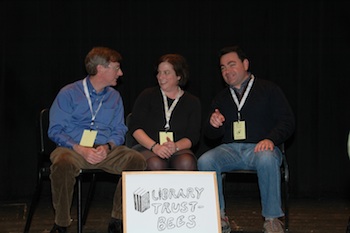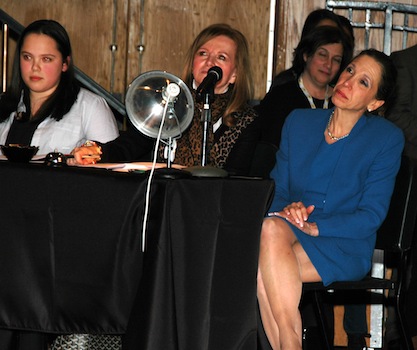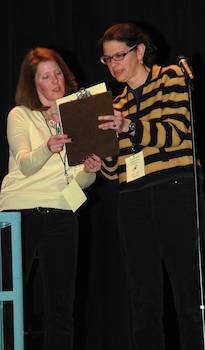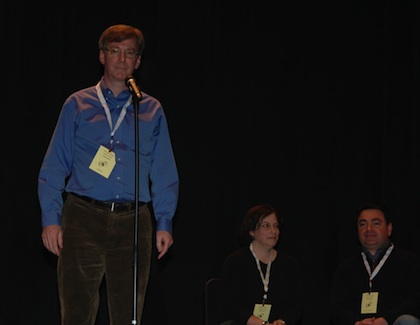Library to Extend Sunday Hours
- Details
- Hits: 3414
Scarsdale Public Library Will Extend Sunday Hours in April : Effective April 7th, the Scarsdale Public Library will be open for an additional hour on Sundays. The library will open its doors at noon and stay open until 5 P.M.
: Effective April 7th, the Scarsdale Public Library will be open for an additional hour on Sundays. The library will open its doors at noon and stay open until 5 P.M.
The library had been open noon to 5 P.M. on Sundays until June 2010 when budget cuts forced them to reduce hours on that one day per week. Since that time, many patrons have commented that they have missed this extra time, so the board is looking forward to reinstating it.
"We understand the importance that leisure time plays in our community members' lives," said Elizabeth Bermel, director of the Scarsdale Library. "We know that it is always difficult to fit things in and create that balance with so many added responsibilities. We are thrilled to be able to bring back this hour on Sundays and we will continue to look for ways to bring added value to our patrons."
Beasts of the Southern Wild to be Shown at Scarsdale Library:
February's independent film is "Beasts of the Southern Wild," an American film nominated for Oscars for Best Picture, Best Director, Best Actress, and Best Adapted Screenplay. It is in English (there will be subtitles), runs 1h 33m, and is rated PG-13. The film will be shown on March 13 at 6 pm and March 15 at 2 pm at the library.
Teeming with magic, beauty and pure joy, this crowd-pleasing winner at Sundance Film Festival has emerged as one of the year's most acclaimed films. Newcomer Quvenzhané Wallis is spectacular as Hushpuppy, the tenacious six-year-old force of nature in an isolated community. When her tough but loving father Wink succumbs to a mysterious malady, the fierce and determined girl bravely sets out on a journey to save him. But Hushpuppy's quest is hindered by a "busted" universe that melts the ice caps and unleashes an army of prehistoric beasts.
Mark Your Calendar:
The third annual teen writer's conference will be held on Friday April 5th from 5pm to 8 pm.
Scarsdale 15K/4 Mile Run and Spring Eggstravaganza
- Details
- Hits: 5866
 The Scarsdale Parks and Recreation Department will hold the 44th annual 15K/4-mile runs on Sunday, April 7th, at the Scarsdale High School at 9am. A 1 mile Kids Fun Run is also available and will start between 11:00 - 11:30 am for children 12 years old and younger. In addition the Scarsdale Antiques Running Club will be co-sponsoring the Abe Simon Memorial Team race.
The Scarsdale Parks and Recreation Department will hold the 44th annual 15K/4-mile runs on Sunday, April 7th, at the Scarsdale High School at 9am. A 1 mile Kids Fun Run is also available and will start between 11:00 - 11:30 am for children 12 years old and younger. In addition the Scarsdale Antiques Running Club will be co-sponsoring the Abe Simon Memorial Team race.
The races will begin on Brewster Road, and will continue through the Fox Meadow and Greenacres neighborhoods. The police will restrict traffic in the area, although local access will not be denied. A letter will be sent to all residents within the race route to bring their attention to the event. The Police Department will block access to the school at the Wayside Lane entrance at 6:00 AM. Race participants will be able to enter the school from Olmstead and Brewster Roads. The Police will do their best to open the roads as soon as it is safe for the runners.
15K and 4M entry fee is $16 by March 10th, after March 10th the fee is $30. Kids Fun Run entry fee is $15 by March 10th, after March 10th the fee is $25. Pre-Register and receive a free race t-shirt. For more information or to register online visit www.scarsdale.com/recreation or call 914-722-1160.
Spring Eggstravaganza
Spring Has Sprung! The Recreation Department's annual Spring Eggstravaganza. will be held on Saturday March 30th at Scarsdale Middle School from 10:00-11:30. Join them for a Spring time magic show, the annual Egg Hunt, and a chance to win prizes! Admission is free and no registration is required. Don't forget to bring a camera to take your picture with the Holiday Bunny.
Scarsdale Girls Triumph At Swim Meet
- Details
- Hits: 8563
 Three 9 year-old girls from Scarsdale, Megan Lee (Edgewood), Julia Gurden (Greenacres), and Joy Jiang (Fox Meadow) participated in the USA Swimming Eastern Zone Team Qualifier Swim Meet on 2/16 - 2/18 at Lehman College in the 10 & Under category. Overall, there were seven 9 year -old girls entered at the meet from the 57 teams participating, all part of Metropolitan Swimming (www.metroswimming.org).
Three 9 year-old girls from Scarsdale, Megan Lee (Edgewood), Julia Gurden (Greenacres), and Joy Jiang (Fox Meadow) participated in the USA Swimming Eastern Zone Team Qualifier Swim Meet on 2/16 - 2/18 at Lehman College in the 10 & Under category. Overall, there were seven 9 year -old girls entered at the meet from the 57 teams participating, all part of Metropolitan Swimming (www.metroswimming.org).
The entry cut-off times for the Zone Qualifiers are faster than the required times for the Junior Olympics (i.e., the 100 yard butterfly JO time is 1:25.99 and the ZQ time is 1:21.99). All of the girls will also be at the Junior Olympics meet in March. They are members of the Westchester Aquatic Club (Wolverines) Swim Team, coached by Carle Fierro.
Scarsdale Teens Lend a Hand, Grant for AFYA and SHS Blood Drive
- Details
- Hits: 6313
 Kate Schnitzer, Marlee Baumberg, Jacob Stein and Sam Goldstein, all residents of Scarsdale, helped out with 70 Jewish and Catholic teens to pack 140 cartons of nonperishable food for the food pantry run by the Bronx Jewish Community Council (BJCC), a UJA-Federation beneficiary agency. BJCC's food pantry, which operates on a walk-in basis and serves anyone in need, is the third largest in the borough and the only one open five days per week. The pantry has been seeing more clients since Hurricane Sandy created additional need in the area.
Kate Schnitzer, Marlee Baumberg, Jacob Stein and Sam Goldstein, all residents of Scarsdale, helped out with 70 Jewish and Catholic teens to pack 140 cartons of nonperishable food for the food pantry run by the Bronx Jewish Community Council (BJCC), a UJA-Federation beneficiary agency. BJCC's food pantry, which operates on a walk-in basis and serves anyone in need, is the third largest in the borough and the only one open five days per week. The pantry has been seeing more clients since Hurricane Sandy created additional need in the area.
"This year's event is really special. It's great to work with teens from the Catholic community; we share an interest in responding to the needs of those who are hungry in our own backyard," says Marlee Baumberg, 16, of Scarsdale. "Working together to really make a difference is exciting."
Bound by a shared imperative to bring dignity, healing, and hope to all New Yorkers, the UJA-Federation and Catholic Charities of the Archdiocese of New York have joined forces to leverage their vast networks to deliver 1 million meals to the hungry, literally multiplying their impact.
About UJA-Federation of New York: For more than 90 years, UJA-Federation has been a central force for communal planning and philanthropy in the New York Jewish community. Through UJA-Federation, almost 60,000 donors pool their resources to help people in need, inspire a passion for Jewish life and learning, and strengthen Jewish communities around the world -- to address the issues that matter most to Jews and New Yorkers. For information on how to donate or how to volunteer, visit http://www.ujafedny.org.
Photos courtesy of UJA-Federation of New York


 AFYA Receives Grant from the Robin Hood Foundation to Provide Medical Equipment to NY Medical Clinics
AFYA Receives Grant from the Robin Hood Foundation to Provide Medical Equipment to NY Medical Clinics
The Afya Foundation, a large medical supply recovery organization in the Greater New York area, has been awarded $200,000 by the Robin Hood Foundation to assess needs and provide medical equipment to fifty medical clinics serving low-income, immigrant communities in Sandy-torn Brighton Beach, Staten Island and Coney Island. By reopening these practices with Afya's help, more than 25,000 New Yorkers will resume medical care in their local neighborhoods.
"We're proud that the medical equipment and supplies we're providing through the Robin Hood Relief Fund grant will help reopen critically-needed medical practices and change the lives of people still suffering after Hurricane Sandy," said Danielle Butin, founder and executive director of Afya. "As we know from our work in Haiti over the last three years, a physician's ability to ensure well-delivered, local healthcare in the wake of a disaster ultimately impacts long term recovery and the future of a community."
Hurricane Sandy further eroded limited services provided to the communities helped by this project. Among these populations are Brighton Beach's large Russian immigrant community, lower income groups in Coney Island (one of the poorest areas of Brooklyn) and Staten Island's diverse immigrant population from places like Italy, Ireland, Russia, and Puerto Rico.
"The Robin Hood Relief Fund is proud to work with the Afya Foundation and to help them provide desperately needed services to communities that have been devastated by Hurricane Sandy," said Sarah Oltmans, senior program officer of the Robin Hood Foundation. "Afya's cost-effective solution will make a real difference in improving the lives of tens of thousands of New Yorkers struggling to rebuild their lives."
About the Afya Foundation: Inspired by the land, the people and the language, the name Afya is the Kiswahili word for good health. Founded in 2007, Afya has shipped nearly one hundred 40-foot containers holding more than 4 million pounds of medical and humanitarian supplies, with a combined value exceeding $23 million, to more than 30 countries. To facilitate these efforts, Afya has established a regional program to collect medical supplies from numerous venues around the New York area. The Afya Warehouse in Yonkers serves as a temporary supply storage facility where the supplies are sorted, inspected, boxed and packed for shipment by volunteers.
The Afya Foundation depends on volunteer donations to sustain its mission to save and rehabilitate lives at home and abroad. To donate, please visit afyafoundation.org/donate.html.
Annual Blood Drive at SHS: 
The sophomore class of Scarsdale High School will conduct the school's annual Community Blood Drive on Wednesday, March 6 from 8:30 am to 2:30 pm. The Blood Drive will be held in Gyms 1 and 2 in the High School, and will be administered by medical professionals from White Plains Hospital.
A photo ID and Social Security number are required to make a donation for everyone 17 years of age or older; 16-year-olds may donate if they also bring written parental permission in addition to the other documents. The consent form for 16-year-olds can be picked up in Jessica Levenberg's office, Room 376 prior to the blood drive.
Everyone who donates blood will receive a "Scoop Card" good for a free scoop of ice cream from All Good Things, located in the Golden Horseshoe Shopping Center.
Scarsdale Girls Celebrate 14th Birthdays with Gifts for the Edward Williams School
 To celebrate their 14th birthdays, Haley Sontag, Kallen Cohane, Sydney Frydman and Ally Wollach asked their friends to contribute school and art supplies for the children at the Edward Williams School in Mt. Vernon. For the last year and a half the birthday girls have been tutoring elementary school children at the school on a weekly basis through the Amazing Afternoons program, a beneficiary of Westchester Jewish Community Services (WJCS). On Wednesday February 13 they delivered a load of supplies to the children at the school and were greeted by Tashiyah Watkins and Crystal Boache.
To celebrate their 14th birthdays, Haley Sontag, Kallen Cohane, Sydney Frydman and Ally Wollach asked their friends to contribute school and art supplies for the children at the Edward Williams School in Mt. Vernon. For the last year and a half the birthday girls have been tutoring elementary school children at the school on a weekly basis through the Amazing Afternoons program, a beneficiary of Westchester Jewish Community Services (WJCS). On Wednesday February 13 they delivered a load of supplies to the children at the school and were greeted by Tashiyah Watkins and Crystal Boache.
Library Trust-Bees Win Scarsdale Library Spelling Bee
- Details
- Hits: 5536
 With 20 teams in four swarms competing, the auditorium was abuzz with speculation about who would win the Friends of the Scarsdale Library Spelling Bee this year .... would returning champions "Hip to be Square" (Lucas Meyer and Esther Sloan – with Ben Zipursky) be able to match their performance from last year? Or would they be beat out by "Spellyoulaters," a team of high schoolers (Maleeha Chida, Viveka Kymal, Malika Lawrence) who had placed third in 2012? Prospects also looked good for the "Trigens," three generations of the Guggenheimer family who finished in the final four in 2011 and 2012 as well as Heather and Stephan Meilli, joined this year by Katharine Miao to form "The Presbeeterians."
With 20 teams in four swarms competing, the auditorium was abuzz with speculation about who would win the Friends of the Scarsdale Library Spelling Bee this year .... would returning champions "Hip to be Square" (Lucas Meyer and Esther Sloan – with Ben Zipursky) be able to match their performance from last year? Or would they be beat out by "Spellyoulaters," a team of high schoolers (Maleeha Chida, Viveka Kymal, Malika Lawrence) who had placed third in 2012? Prospects also looked good for the "Trigens," three generations of the Guggenheimer family who finished in the final four in 2011 and 2012 as well as Heather and Stephan Meilli, joined this year by Katharine Miao to form "The Presbeeterians."
And if those teams weren't formidable enough, "The Bee Informeds," Debra Banerjee, Linda Leavitt and Todd Sliss from the Scarsdale Inquirer, the "Humblebees", with Marcus Moretti, David Scinto and Jon Ungar and "Bee-Witched, Bothered & Bee-Wildered" (Former School Board Presidents Terri Simon and Florie Wachtenheim with Jonathan Flaxer) would be enough to scare any bee away from the hive.
The contestants, an audience of more than 300 word fiends plus The Friends of the Library and Library Board Members, all pulled out their pens to spell along as the contest began. The Bee was judged by State Assemblywoman Amy Paulin, Scarsdale Mayor Miriam Flisser and Rachel Josselsohn from the Library Teen Advisory Board.
Returning emcee Ed Coleman, aka the voice of the Mets, kept the night lively -- sometimes helping contenders with his pronunciation of difficult words – but other times leading them astray – especially with a few of the words with French origins such as ENSEINTE, PEIGNOIR and EPERGNE. After months of anticipation, a few of the leading contenders were out in a flash while some new stars flew into view.
 In the first round, four skilled teams battled to the finish, until Coleman was forced to move to the list of most difficult words and broke the tie with the word BALMACAAN– an overcoat with raglan sleeves. I had never heard that word before, and certainly don't own a balmacaan, and the word proved to be a deal breaker in round one. The only team who got it right was the Library Trust-Bees – a group from the Board of Trustees of the Scarsdale Library including Warren Breakstone, Barbara Josselsohn and Seth Ross. The Trust-Bees triumphed in the first swarm and continued to wow the audience with their expertise all night long.
In the first round, four skilled teams battled to the finish, until Coleman was forced to move to the list of most difficult words and broke the tie with the word BALMACAAN– an overcoat with raglan sleeves. I had never heard that word before, and certainly don't own a balmacaan, and the word proved to be a deal breaker in round one. The only team who got it right was the Library Trust-Bees – a group from the Board of Trustees of the Scarsdale Library including Warren Breakstone, Barbara Josselsohn and Seth Ross. The Trust-Bees triumphed in the first swarm and continued to wow the audience with their expertise all night long.
The second swarm was also lengthy and the teams breezed through challenging words like ANTEDILUVEAN, LEPRECHAUN and VINAIGRETTE. No one was able to spell WEDEL (short swing turns made by skiers) and the Bee Informeds finally emerged as the victors when they were the only team to spell KALANCHOE (a succulent flowering plant).
In swarm three, a team of physicians showed their stuff, after two teams misspelled LABYRINTH – and another  team tripped up on OBSEQUIOUS. The remaining two teams got past BACCHANAL, both misspelled QUOKKA (a small marsupial from Australia!) with ENCEINTE breaking the tie.
team tripped up on OBSEQUIOUS. The remaining two teams got past BACCHANAL, both misspelled QUOKKA (a small marsupial from Australia!) with ENCEINTE breaking the tie.
The next and final swarm consisted of four teams of students – the first falling on HALLELUJAH, with the four remaining teams stumped by ENNOBLE and the round ending with QUERELOUS. The Spellulators were on for the finals again!
Though in the initial rounds the teams wrote their answers on erasable boards, in the final round, one representative from each team had to stand before the audience and spell the word aloud. This increased the pressure, and also the possibility for error.
Back for the final round after intermission and refreshments were The Library Trust-Bees (Breakstone, Josselsohn and Ross), The Bee-Informeds (Banerjee, Leavitt and Sliss from the Inquirer), the Bee MDS (Jim and Seth Pullman and Mark Dursztman) and the Spellyoulaters (Maleeha Chida, Viveka Kymal and Malika Lawrence).
The students were out after they added an extra S to STREUSEL, and the Bee Informeds quickly followed, misspelling PERENNIAL (Perinnial). That left Seth Ross and Jim Pullman to vie for the title at the mike. A confident speller, Ross spelled SABOTUER, followed by Pullman with CAMPHOR and Ross with PECCADILLO. Then the docs got lucky when they were given the word DIPHTHERIA and Ross continued with MERINGUE. But in the end, it was a drink that tripped up the medical squad. Pullman included a C in the spelling of DAIQUIRI and first place was won by the library trustees – a nice reward for the work they do to support the library.
 This year, proceeds from the event will go toward the creation of a business center at the library, including office equipment. Also in the works is a redesign of the interior of the library. It looked like the proceeds from the 2013 Spelling Bee will go a long way toward helping the library accomplish their plans. Congratulations to all the contestants and to the Friends of the Scarsdale Library for a job well done.
This year, proceeds from the event will go toward the creation of a business center at the library, including office equipment. Also in the works is a redesign of the interior of the library. It looked like the proceeds from the 2013 Spelling Bee will go a long way toward helping the library accomplish their plans. Congratulations to all the contestants and to the Friends of the Scarsdale Library for a job well done.
Photo Credit: Eric Levine










